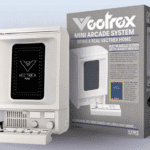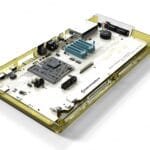John is a former contributor with a collection of interesting retro gaming recollections.
In a recent feature list, co-writer and hardcore arcade enthusiast Zahir gave voice to his favourite arcade racers of the nineties. A super scaling list on the whole, and one that started me thinking about my own, and about what arcade racing games meant to me at that time.
In simple terms, by the mid-nineties, arcade racing games were some cool beans. Polygons were working nicely for fighting games and shooters but they were really working for racing games. And racing games had that low bar of entry which meant that even your mum could manage a lap or two of multiplayer Daytona. And that made them right little coin munchers. Remember walking along a seafront arcade? What were the attention-grabbing machines that littered the entrances? Racing games for the most part, with their super peak fidelity and high frames per second, again for the most part.
So mine will be a personal list in keeping with Zahir’s. I’ll start with some familiar old ground…
1. Sega Rally Championship
An entry perhaps beyond the per functionary, but Sega Rally’s Euro cool, Martini iced facade was the last word in 90s media classicism. It’ll outlive Reservoir Dogs, and so it should. Nothing looked so rich and shifted so smooth as when Sega Rally parked up at your local arcade in 1995.
The cabinet had that familiar Victorian engineering quality that encouraged vigour and the monitors were mountainous with resolution. Daytona had been an absolute triumph already in the arcade for Sega and had all the bluster, but Sega Rally brought a sharp style.
Daytona was lager; Sega Rally was champagne.
The cabinet might have encouraged, but the handling required a righteous sympathy to a tail as happy as a Labrador. But by golly it was balanced. On your over-correcting route to managing your first decent slide, your errors could always be felt as your own and not design. By the time I had shovelled a few quid into the first machine that I played, I came away aware that this machine was unparalleled.
Utterly distinct and as deep in its control as its facade was wide with appeal. Nothing could get close to the charisma, but for a stupendous effort in converting the game to the Saturn, and a notable hand at Euro cool a couple of years later from Konami…
2. Club GTI Rally Cote D’Azur
Konami is a name as old as the video game Sun, and present across most platforms for most of the day. They were less considerable in the arcades by the time that Club GTI handbrake turned itself into everyone’s attention in late 1996. It was a little scrappy about the textures and update, but goodness it had a spirit that came from an adjacent stable to Sega Rally in terms of European fantasia. And it was a little looser, a little more the fool.
Still a circuit racing game, but one now full of short-cuts and other chases, all available to the player around the espresso sharp, southern French township. The addition of a Mini as the lead car gave it an Italian Job pedigree and the use of a handbrake gave it some flick and heft.
It was not a particularly fast game, even though the engine the machine it ran off always seemed to be one frame away from collapsing. It appeared at around the same time as Sega’s Scud Race and you really couldn’t help but notice that Sega had by this point transcended to another level with their arcade hardware. But Club GTI had charm, good instincts, a joy of place and hand braking cars around shady shortcuts. An absolute gem. You paid it money, it made you smile.
3. Alpine Racer 2
We all liked to be on top of an arcade leaderboard. Three little letters that say you are the best. Champion. Distinct. Now, I am not talking about myself here but for one exception. You can probably guess where this is going.
Coin-op legends Namco took a grand swing at taking on Sega down the arcades in the 90s, although I grant you that choosing 1996’s Alpine Racer 2 over their earlier Ridge Racer is a marginal position to take. But I won at that sucker, and it was a legitimate racer. It was in the title and when I first played it I must have been in the mood because after a couple of over-corrections on the simulation-positive faux skis, I was swooshing myself with aplomb down that remedial slope. The graphics were great, all Foxes’ Glacier Mint (can you still get those? -Ed) with blue hints and wicked sharp resolution. After my first go, I was in for another few quid.
I have never skied, or skieded, whichever it is, but those programmers had a subtle understanding of motion with this one. Not at all dissimilar from Sega Rally in fact. Plus a frequent sense of drama with those sheer drops and lavish scale.
And there on top of the scoreboard, just for a little while, was my name.
4. Manx TT Superbike
Motorcycles and arcades. Two things that combined were sure to take your pocket money. Add the same development team who made Sega Rally and you wind up with the greatest arcade motorcycle racer ever, and no one with any money left in their pockets.
Sega pushed the design brief out with this one and the cabinet was replete with a pivoting polymer bike, bob-on chunky Model 2 visuals and outrageously revvy sounds. Manx might never have had the fine finesse of Rally, and having only two selectable tracks was bordering on the offensive, but in the arcade it played big, especially if it was one of those eight-player link-ups that were out there in the wild, but which I never saw myself. I did see and indeed purchase the Saturn conversion which followed. Still two tracks… full price game though so that was nice.
Thanks, Sega.
Apparently, I have complaints about this game, and they may or may not be fair, but if you had played Manx TT back yonder it would have grabbed you by the pivots and swung you back and forth until all your small change fell out.
5. Scud Race
Sega’s AM2 had defined arcade racing over and over with a rollout of titles that you, me and everyone else could not ignore. Outrun, Power Drift, Virtua Racing, Daytona USA. And then in 1996 Scud Race, or Sega GT as it was known in other parts. It was the second Model 3-powered Sega arcade after Virtua Fighter 3 and opened a technical lead over the competition that was comprehensive. And it played like a dragon.
Effectively a smoother Daytona USA-style game, but now in an international coat of many amazing textures and a choice of four exotic supercars. I’ll save you the tension. I did not come top of the score with this one. I don’t even think I finished a race for my first few quid. It was hectic stuff with locations and sparks and colours going off everywhere, but it had been made by AM2 so it was as fluid as it was demanding. Amongst the fast crashing, there was always fast passing of the many other cars and a present sense of fast cars moving very fast indeed. Stellar stuff from when AM2 were the last word.
Arcade racing: a worldwide pastime
So there we go. That was then, and back then, although fighting games and shooters had come home quite intact indeed, the home couldn’t begin to comprehend a racing game cabinet. Even modern racing rigs are still resolutely awful. The developers of these games deserved every piece of change that they relieved me of. Salutations.
Affiliate Disclosure: Some of the links in this post may be affiliate links, which means I may earn a small commission if you make a purchase through those links. This comes at no extra cost to you. Thank you for your support!
John is a former contributor with a collection of interesting retro gaming recollections.







